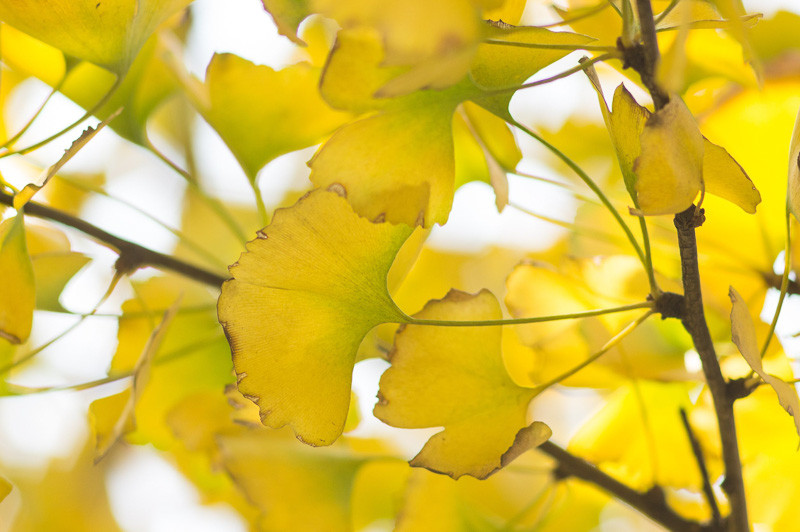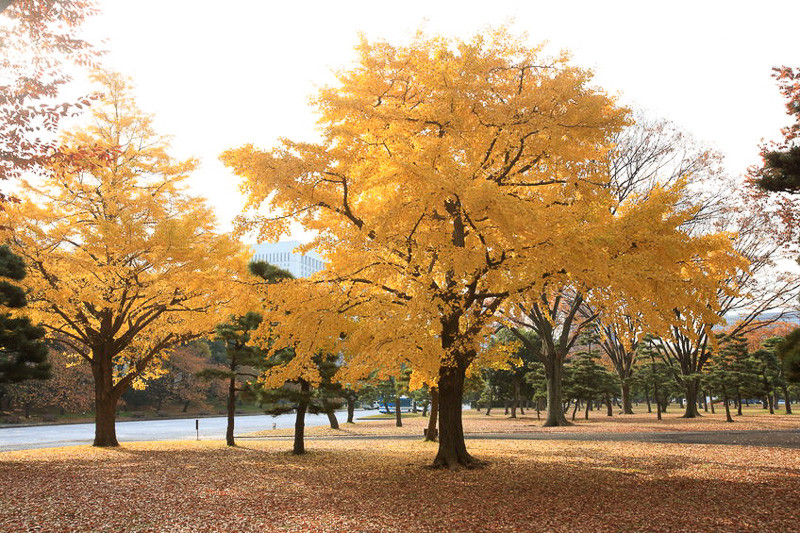Maidenhair Tree, Fossil Tree, Icho
Ginkgo biloba is often referred to as a “living fossil,” as it has no close living relatives and resembles fossils dating back over 200 million years. The tree was thought extinct in the wild and was only known to exist in temple gardens in China before being rediscovered in the wild in the 20th century.
Ginkgo’s ability to withstand major catastrophic events, including the bombing of Hiroshima, where it was one of the few living things to survive near the blast site, has made it a symbol of resilience and peace.
Ginkgo biloba’s unique biological and historical significance, combined with its beauty and utility, continues to fascinate botanists, gardeners, and urban planners alike. Its presence enriches our landscapes and connects us to the deep past, reminding us of nature’s endurance and adaptability.
Ginkgo biloba is distinguished by its unique fan-shaped leaves, which turn a vibrant yellow in autumn. It is commonly known as the maidenhair tree due to the resemblance of its leaves to the pinnae of the maidenhair fern (Adiantum genus).
Native: Originally from China, Ginkgo biloba is the last surviving member of a group of ancient plants believed to have inhabited the earth up to 270 million years ago.
Plant Type and Habit: Ginkgo is a deciduous conifer, a rarity, as most conifers are evergreen. It has a distinctive, irregular growth habit in youth, becoming more pyramidal with age. The tree is dioecious with separate male and female trees. It’s known for its longevity, with some specimens living over a thousand years. The oldest known Ginkgo biloba tree is believed to be within the walls of a Buddhist temple in the Zhongnan Mountains of China. This tree is estimated to be over 1,400 years old.
Size: Ginkgo trees can grow 50-80 feet tall (15-24 meters), with a spread of 30-40 feet (9-12 meters). Some ancient specimens have grown over 100 feet tall (30 meters).
Flowers: The flowers of Ginkgo biloba bloom in spring, but they are not conspicuous. Male trees produce small, yellowish catkins, while female trees produce singular ovulate flowers that mature into seeds.
Fruits: The “fruits” of Ginkgo are actually seeds with a fleshy outer layer. Female trees produce these seeds in late autumn and can emit an unpleasant odor when ripe.
Foliage: Adding visual interest and beauty to the landscape, its spreading canopy of unique, fan-shaped, rich green leaves turns a stunning yellow color in the fall.
Bark: The bark of Ginkgo biloba is grey, rough, and deeply furrowed, adding winter interest.
Hardiness: Ginkgo is exceptionally hardy, tolerating zones 3-9.
Uses: Graceful and attractive in all seasons, Ginkgo biloba is a cherished shade tree that is easily established. It withstands urban pollution, making it also a popular street tree. Beyond its ornamental value, Ginkgo biloba is used in traditional medicine and is believed to enhance cognitive functions. The leaves are harvested to make ginkgo extract.
Wildlife: Ginkgo biloba does not significantly attract wildlife due to its lack of nectar-rich flowers or fleshy fruits. However, its seeds, once they drop and the outer layer is removed, can be consumed by squirrels and certain birds that appreciate the nut inside.
Deer and Rabbits: Ginkgo biloba is highly resistant to damage from deer, making it an excellent choice for areas where these animals are prevalent.
Drought / Salt Tolerance: Once established, Ginkgo biloba is highly drought-tolerant, requiring minimal irrigation. It is also salt, heat, and pollution tolerant.
Toxicity: While the seeds are edible when cooked, the outer fleshy layer of the fruit can cause skin irritations and allergic reactions in some people. The seeds contain ginkgotoxin, which can be toxic to humans and pets in large quantities.
Invasiveness: Ginkgo biloba is not considered invasive. Its slow growth rate and specific reproductive biology limit its spread.
Benefits: Its leaves have been used in traditional medicine for millennia, and modern research explores its potential in memory enhancement and circulation improvement. Its resistance to pollution and adaptability to urban environments make it an invaluable addition to city landscapes.


Ginkgo biloba trees are remarkably resilient and have few significant problems regarding pests and diseases. Their ancient lineage has equipped them with excellent defenses, making them a low-maintenance choice for many landscapes. However, like all trees, they are not entirely immune to issues.
Ginkgo Leafminers (Stigmella multispicata): This pest is one of the few that specifically targets Ginkgo, causing minor damage by creating tunnels in the leaves. However, it rarely harms the overall health of the tree.
Aphids: Sometimes, aphids may infest Ginkgo trees, sucking sap from the leaves and producing honeydew, which can lead to sooty mold. Aphid problems are usually minor and can be managed with water sprays or insecticidal soap.
Botrytis (Gray Mold): This fungus might affect the leaves in extremely wet conditions, but it’s rare and typically not severe.
Verticillium Wilt: Although infrequent, Verticillium wilt can affect Ginkgo, causing wilting and death of branches. There’s no chemical control, but maintaining tree health can help prevent infection.
Fruit Odor: Female Ginkgo trees produce fruit that, when decomposed, releases butyric acid, smelling like rancid butter. This is often considered the most significant drawback of planting female Ginkgo trees in urban or residential areas.
Root Space: Ginkgo trees prefer not to be confined, so limited root space in urban settings can sometimes inhibit their growth, though they generally adapt well to such conditions.
Soil Compaction: While Ginkgo trees are tolerant of many urban challenges, severely compacted soil can limit growth and vigor.
| Hardiness |
3 - 9 |
|---|---|
| Heat Zones |
3 - 9 |
| Climate Zones | 1A, 1B, 2A, 2B, 3A, 3B, 4, 5, 6, 7, 8, 9, 10, 12, 14, 15, 16, 17, 18, 19, 20, 21, 22, 23, 24, A3 |
| Plant Type | Conifers, Trees |
| Plant Family | Ginkgoaceae |
| Genus | Ginkgo |
| Common names | Maidenhair Tree, Ginkgo Tree |
| Exposure | Full Sun |
| Season of Interest |
Spring (Mid, Late) Summer (Early, Mid, Late) Fall |
| Height |
50' - 80' (15.2m - 24.4m) |
| Spread |
30' - 40' (9.1m - 12.2m) |
| Maintenance | Low |
| Water Needs | Low, Average |
| Soil Type | Chalk, Clay, Loam, Sand |
| Soil pH | Acid, Alkaline, Neutral |
| Soil Drainage | Well-Drained |
| Characteristics | Showy |
| Tolerance | Deer, Clay Soil, Drought, Salt |
| Garden Styles | Informal and Cottage, Prairie and Meadow, City and Courtyard |
| Hardiness |
3 - 9 |
|---|---|
| Heat Zones |
3 - 9 |
| Climate Zones | 1A, 1B, 2A, 2B, 3A, 3B, 4, 5, 6, 7, 8, 9, 10, 12, 14, 15, 16, 17, 18, 19, 20, 21, 22, 23, 24, A3 |
| Plant Type | Conifers, Trees |
| Plant Family | Ginkgoaceae |
| Genus | Ginkgo |
| Common names | Maidenhair Tree, Ginkgo Tree |
| Exposure | Full Sun |
| Season of Interest |
Spring (Mid, Late) Summer (Early, Mid, Late) Fall |
| Height |
50' - 80' (15.2m - 24.4m) |
| Spread |
30' - 40' (9.1m - 12.2m) |
| Maintenance | Low |
| Water Needs | Low, Average |
| Soil Type | Chalk, Clay, Loam, Sand |
| Soil pH | Acid, Alkaline, Neutral |
| Soil Drainage | Well-Drained |
| Characteristics | Showy |
| Tolerance | Deer, Clay Soil, Drought, Salt |
| Garden Styles | Informal and Cottage, Prairie and Meadow, City and Courtyard |
How many Ginkgo biloba (Maidenhair Tree) do I need for my garden?
| Plant | Quantity | |
|---|---|---|
| Ginkgo biloba (Maidenhair Tree) | N/A | Buy Plants |
Create a membership account to save your garden designs and to view them on any device.
Becoming a contributing member of Gardenia is easy and can be done in just a few minutes. If you provide us with your name, email address and the payment of a modest $25 annual membership fee, you will become a full member, enabling you to design and save up to 25 of your garden design ideas.
Join now and start creating your dream garden!
Create a membership account to save your garden designs and to view them on any device.
Becoming a contributing member of Gardenia is easy and can be done in just a few minutes. If you provide us with your name, email address and the payment of a modest $25 annual membership fee, you will become a full member, enabling you to design and save up to 25 of your garden design ideas.
Join now and start creating your dream garden!